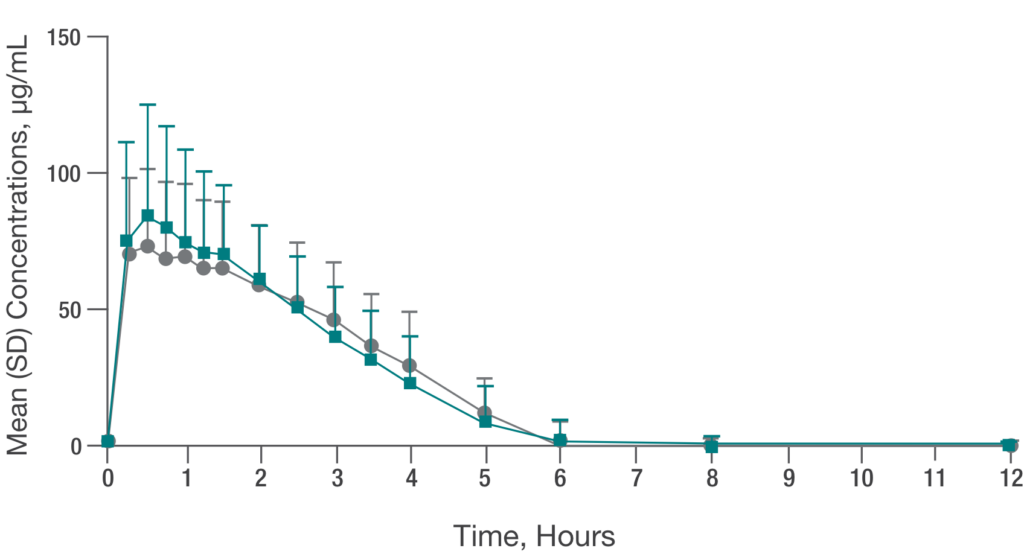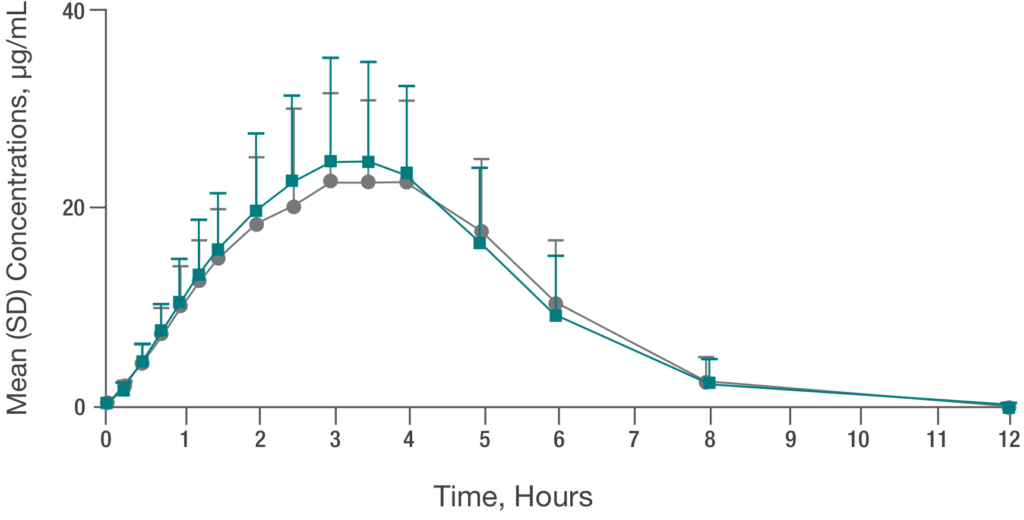Convenient single-dose envelopes provide your UCD patients
Ammonia control
on the go
Welcome to OLPRUVA® (sodium phenylbutyrate) for oral suspension!
OLPRUVA is a nitrogen-binding agent indicated as adjunctive therapy to the standard of care, which includes dietary management, in the chronic management of adult and pediatric patients, weighing 20 kg or greater and with a body surface area (BSA) of 1.2 m2 or greater, with urea cycle disorders (UCDs) involving deficiencies of carbamylphosphate synthetase (CPS), ornithine transcarbamylase (OTC), or argininosuccinic acid synthetase (AS).1
Each single-dose envelope contains the premeasured OLPRUVA packet(s) and Mix-Aid packet needed to mix 1 dose.1
Limitation of Use
OLPRUVA is not indicated for the treatment of acute hyperammonemia, which can be a life-threatening medical emergency that requires rapidly acting interventions to reduce plasma ammonia levels.1
A unique formulation of sodium phenylbutyrate designed with your patients in mind1,2
OLPRUVA offers the efficacy of sodium phenylbutyrate in a novel formulation.1,2

OLPRUVA offers the efficacy of sodium phenylbutyrate in a novel formulation.1,2
- Palatable—Dual-coating* formulation designed for palatability1-3
- Premeasured—Convenient individual dose packets support dosing accuracy1
- Portable—Discreet single-dose envelopes are easily carried when your patients are on the go1
*The active ingredient of OLPRUVA is covered by a seal coating and an outer polymer coating.
Demonstrated bioequivalence to sodium
phenylbutyrate powder1,2
The active ingredient of OLPRUVA is sodium phenylbutyrate, first approved by the FDA in a medication for treating UCDs in 1996.4
- Sodium phenylbutyrate has been foundational therapy for UCDs for more than 20 years5
- OLPRUVA was approved by the FDA as a 505(b)(2) application, primarily based on2,6:
- Bioequivalence to sodium phenylbutyrate powder1,2
- FDA evaluation of safety and effectiveness of sodium phenylbutyrate powder4,6

Like other nitrogen-binding agents that treat UCDs, OLPRUVA is metabolized to phenylacetate, the metabolically active compound that facilitates nitrogen excretion.1
- Phenylacetate conjugates with glutamine to form phenylacetylglutamine, which provides an alternate vehicle for waste nitrogen excretion1
- The OLPRUVA formulation is proprietary and patented
Most common adverse reactions (incidence ≥3%) are amenorrhea or menstrual
dysfunction (irregular menstrual cycles), decreased appetite, body odor, and bad
taste or taste aversion.1
OLPRUVA was shown to be bioequivalent to sodium
phenylbutyrate powder in two phase 1 pharmacokinetic studies7
Two phase 1 studies were conducted in healthy adult volunteers (N=37), using a single-dose (5 g of active ingredient, ie, sodium phenylbutyrate), 3-period, 3-sequence crossover design. Study drugs were given on days 1-37:
- In Study 1, subjects received OLPRUVA with a high-fat meal (fed), OLPRUVA fasted, and sodium phenylbutyrate powder fasted; OLPRUVA was prepared with modified Mix-Aid†
- In Study 2, subjects received OLPRUVA with Mix-Aid† and sodium phenylbutyrate powder—all under fed conditions
Plasma concentrations of phenylbutyrate and the active metabolite phenylacetic acid (PAA) were determined using liquid chromatography-tandem mass spectrometry, and plasma samples were collected from all subjects prior to dosing and at multiple timepoints following study-drug administration.7
†Mix-Aid (called Thick-It in the phase 1 studies) is 100% modified food starch used in commercially available OLPRUVA.
Mean Plasma Concentrations
of Phenylbutyrate Under Fed
Conditions7


OLPRUVA is rapidly converted into the active metabolite phenylacetate, which allows for removal of ammonia.
Mean Plasma Concentrations
of Phenylacetate Under
Fed Conditions7


Increased exposure to phenylacetate, the major metabolite of OLPRUVA, may be associated with neurotoxicity in patients with UCDs. If neurotoxicity symptoms of vomiting, nausea, headache, somnolence, or confusion are present in the absence of high ammonia levels or other intercurrent illnesses, consider reducing the dose of OLPRUVA.
Total systemic exposures (AUCinf) and peak exposures (Cmax) of phenylbutyrate and phenylacetate were bioequivalent for OLPRUVA and sodium phenylbutyrate powder in the fasted and fed states.1,7
OLPRUVA should always be taken with food. Under fasted conditions, the Cmax and AUCinf were increased by 138% and 103%, respectively, for phenylbutyrate and 50% and 60%, respectively, for phenylacetate when compared to when OLPRUVA was administered with a high-fat meal.‡
The maximum recommended daily dose for OLPRUVA is 20 grams.1
‡These data were derived from mean values for Cmax and AUCinf.
Cmax and AUC of Phenylbutyrate and Phenylacetate Following a Single Oral Dose Administration of OLPRUVA (5 g) in Healthy Subjects Under Fasted and Fed Conditions1,8
| Phenylbutyrate Results | Phenylacetate Results | |||
|---|---|---|---|---|
| Pharmacokinetic Parameters | Fasted Conditions (Mean ± SD) | Fed Conditions (Mean ± SD) | Fasted Conditions (Mean ± SD) | Fed Conditions (Mean ± SD) |
| Cmax (µg/mL) | 229 ± 48 | 96 ± 34 | 39 ± 14 | 26 ± 10 |
| AUCinf (hr•µg/mL) | 510 ± 129 | 251 ± 90 | 183 ± 76 | 114 ± 43 |

Healthcare professionals
If you manage patients with UCDs, sign up to get more information and updates about OLPRUVA.
Learn about
OLPRUVA
dosing options
Get the OLPRUVA
Prescription
Enrollment Form
Indication and Important Safety Information for OLPRUVA
OLPRUVA [ol proo vah] (sodium phenylbutyrate) for oral suspension
Indication
OLPRUVA is a nitrogen-binding agent indicated as adjunctive therapy to the standard of care, which includes dietary management, in the chronic management of adult and pediatric patients, weighing 20 kg or greater and with a body surface area (BSA) of 1.2 m2 or greater, with urea cycle disorders (UCDs) involving deficiencies of carbamylphosphate synthetase (CPS), ornithine transcarbamylase (OTC), or argininosuccinic acid synthetase (AS).
Limitation of Use
OLPRUVA is not indicated for the treatment of acute hyperammonemia, which can be a life-threatening medical emergency that requires rapidly acting interventions to reduce plasma ammonia levels.
Important Safety Information
Warnings and Precautions
Neurotoxicity of Phenylacetate: Increased exposure to phenylacetate, the major metabolite of OLPRUVA, may be associated with neurotoxicity in patients with UCDs. If neurotoxicity symptoms of vomiting, nausea, headache, somnolence, or confusion are present in the absence of high ammonia levels or other intercurrent illnesses, consider reducing the dose of OLPRUVA.
Hypokalemia: Renal excretion of phenylacetylglutamine may induce urinary loss of potassium. Monitor serum potassium during therapy and initiate appropriate treatment when necessary.
Conditions Associated with Edema: OLPRUVA contains 124 mg of sodium per gram of sodium phenylbutyrate, and the Mix-Aid contains 5 mg of sodium per packet. Calculate the total amount of sodium based on the patient’s body surface area. If a patient develops new-onset edema or worsening edema while on treatment, discontinue administration of sodium phenylbutyrate and initiate appropriate therapy.
Drug Interactions
Valproic acid, haloperidol, or corticosteroids may increase plasma ammonia levels. Monitor ammonia levels closely. Probenecid may inhibit renal excretion of metabolites of OLPRUVA including phenylacetate and phenylacetylglutamine; monitor for potential neurotoxicity.
Use in Specific Populations
No studies with OLPRUVA have been conducted in subjects with renal or hepatic impairment. Monitor ammonia levels and in patients with hepatic impairment, it is recommended to start at the lowest dose that controls ammonia levels. Dose selection for elderly patients should be cautious, usually starting at the low end of the dosing range.
OLPRUVA should be used with caution in patients who are pregnant or planning to become pregnant. Report pregnancies to the manufacturer. There are no data on the presence of OLPRUVA in human milk, the effects on the breastfed infant, nor the effects on milk production. This should be considered when assessing the mother’s need for OLPRUVA.
Adverse Reactions
Most common adverse reactions (incidence ≥ 3%) are amenorrhea or menstrual dysfunction (irregular menstrual cycles), decreased appetite, body odor and bad taste or taste aversion.
You are encouraged to report negative side effects of prescription drugs to the FDA. Visit www.fda.gov/medwatch or call 1-800-FDA-1088.
This information is not comprehensive.
For additional information, please see full Prescribing Information for OLPRUVA on OlpruvaHCP.com.
Indication and Important Safety Information for OLPRUVA
OLPRUVA [ol proo vah] (sodium phenylbutyrate) for oral suspension
Indication
OLPRUVA is a nitrogen-binding agent indicated as adjunctive therapy to the standard of care, which includes dietary management, in the chronic management of adult and pediatric patients, weighing 20 kg or greater and with a body surface area (BSA) of 1.2 m2 or greater, with urea cycle disorders (UCDs) involving deficiencies of carbamylphosphate synthetase (CPS), ornithine transcarbamylase (OTC), or argininosuccinic acid synthetase (AS).
Limitation of Use
OLPRUVA is not indicated for the treatment of acute hyperammonemia, which can be a life-threatening medical emergency that requires rapidly acting interventions to reduce plasma ammonia levels.
Important Safety Information
Warnings and Precautions
Neurotoxicity of Phenylacetate: Increased exposure to phenylacetate, the major metabolite of OLPRUVA, may be associated with neurotoxicity in patients with UCDs. If neurotoxicity symptoms of vomiting, nausea, headache, somnolence, or confusion are present in the absence of high ammonia levels or other intercurrent illnesses, consider reducing the dose of OLPRUVA.
Hypokalemia: Renal excretion of phenylacetylglutamine may induce urinary loss of potassium. Monitor serum potassium during therapy and initiate appropriate treatment when necessary.
Conditions Associated with Edema: OLPRUVA contains 124 mg of sodium per gram of sodium phenylbutyrate, and the Mix-Aid contains 5 mg of sodium per packet. Calculate the total amount of sodium based on the patient’s body surface area. If a patient develops new-onset edema or worsening edema while on treatment, discontinue administration of sodium phenylbutyrate and initiate appropriate therapy.
Drug Interactions
Valproic acid, haloperidol, or corticosteroids may increase plasma ammonia levels. Monitor ammonia levels closely. Probenecid may inhibit renal excretion of metabolites of OLPRUVA including phenylacetate and phenylacetylglutamine; monitor for potential neurotoxicity.
Use in Specific Populations
No studies with OLPRUVA have been conducted in subjects with renal or hepatic impairment. Monitor ammonia levels and in patients with hepatic impairment, it is recommended to start at the lowest dose that controls ammonia levels. Dose selection for elderly patients should be cautious, usually starting at the low end of the dosing range.
OLPRUVA should be used with caution in patients who are pregnant or planning to become pregnant. Report pregnancies to the manufacturer. There are no data on the presence of OLPRUVA in human milk, the effects on the breastfed infant, nor the effects on milk production. This should be considered when assessing the mother’s need for OLPRUVA.
Adverse Reactions
Most common adverse reactions (incidence ≥ 3%) are amenorrhea or menstrual dysfunction (irregular menstrual cycles), decreased appetite, body odor and bad taste or taste aversion.
You are encouraged to report negative side effects of prescription drugs to the FDA. Visit www.fda.gov/medwatch or call 1-800-FDA-1088.
This information is not comprehensive.
For additional information, please see full Prescribing Information for OLPRUVA on OlpruvaHCP.com.
References
- OLPRUVA® (sodium phenylbutyrate) for oral suspension. Prescribing information. Newton, MA: Acer Therapeutics Inc.
- Appel LE, Shockey JR, Schelling DC, inventors; Acer Therapeutics Inc, assignee. Palatable compositions including sodium phenylbutyrate and uses thereof. US patent 11,154,521 (B2). October 26, 2021.
- Keating AV, Soto J, Tuleu C, Forbes C, Zhao M, Craig DQM. Solid state characterisation and taste masking efficiency evaluation of polymer based extrudates of isoniazid for paediatric administration. Int J Pharm. 2018;536(2):536-546.
- US Department of Health and Human Services, Food & Drug Administration. Drugs@FDA: FDA-approved drugs, NDA 020572. Accessed March 29, 2022. https://www.accessdata.fda.gov/scripts/cder/daf/index.cfm?event=overview.process&varApplNo=020572
- Osaka S, Nakano S, Mizuno T, et al. A randomized trial to examine the impact of food on pharmacokinetics of 4-phenylbutyrate and change in amino acid availability after a single oral administration of sodium 4-phenylbutyrarte in healthy volunteers. Mol Genet Metab. 2021;132(4):220-226.
- US Department of Health and Human Services, Food and Drug Administration, Center for Drug Evaluation and Research (CDER). Determining Whether to Submit an ANDA or a 505(b)(2) Application: Guidance for Industry. Food and Drug Administration; May 2019. Accessed April 25, 2022. https://www.fda.gov/media/124848/download
- Cederbaum SD, Edwards J, Kellmeyer T, Peters Y, Steiner RD. Taste-masked formulation of sodium phenylbutyrate (ACER-001) for the treatment of urea cycle disorders. Mol Genet Metab. 2023;138(4):107558.
- Data on file. Acer Therapeutics Inc.




